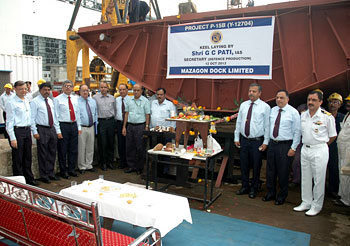INDIAN ARMED FORCES CHIEFS ON OUR RELENTLESS AND FOCUSED PUBLISHING EFFORTS

The insightful articles, inspiring narrations and analytical perspectives presented by the Editorial Team, establish an alluring connect with the reader. My compliments and best wishes to SP Guide Publications.

"Over the past 60 years, the growth of SP Guide Publications has mirrored the rising stature of Indian Navy. Its well-researched and informative magazines on Defence and Aerospace sector have served to shape an educated opinion of our military personnel, policy makers and the public alike. I wish SP's Publication team continued success, fair winds and following seas in all future endeavour!"

Since, its inception in 1964, SP Guide Publications has consistently demonstrated commitment to high-quality journalism in the aerospace and defence sectors, earning a well-deserved reputation as Asia's largest media house in this domain. I wish SP Guide Publications continued success in its pursuit of excellence.
- MoD initiates comprehensive review of Defence Acquisition Procedure 2020, pushes for defence reforms
- G7: The Swansong
- Kalinga Connect: South Asia to Polynesia
- Advanced MRSAM for India for a greater firepower
- Must Credit DRDO for Operation Sindoor, now what is next for defence R&D?
- Operation Sindoor | Day 2 DGMOs Briefing
- Operation Sindoor: Resolute yet Restrained
Kolkata commissioned, focus shifts to P15 Bravo



With the first P15A destroyer INS Kolkata finally in service after several slippages, and Mazagon Dock Ltd (MDL) expected to follow through with the deliveries of the INS Chennai and INS Kochi on time, resource and planning focus at India's premier shipbuilder will shift to the prospectively more capable P15 Bravo (P15B) multi-mission destroyers. The keel for the first P15B was laid in October last year (10 months after production began), with a sanction for four ships built on the same line and deliveries to take place in 2018, 2020, 2022, and 2024 for all four ships.
With an official displacement of 7,300 tons, MDL intends to shave off about 200 tons of superstructure mass from the new line to contribute to stealth performance. The design displacement will be closer to 6,800 tons, making it a significantly more stealthy destroyer than the Kolkata-class, a fact borne out also, at least, in naval drawings shared with media. MDL has pushed for a standardised hull and propulsion package to avoid build delays and other pitfalls. The Directorate of Naval Design has worked with Russia's Northern Design Bureau in St. Petersburg to finetune the design over P15A, while the Baltic Shipyard has been contracted to provide shaft lines for the platforms.
In April this year, MDL invited expression of interest from Indian firms for block fabrication, outfitting, transportation and delivery of blocks to MDL for the P15B build, a signal that its joint ventures with private shipyards L&T and Pipavav hadn't quite delivered what they were supposed to. The company has said, "MDL intends to leverage capacities available within the country both in the private and public sectors to ensure that the P15B ships are delivered to the Indian Navy in the contractual timelines." The sentiment can scarcely be understated. A combination of factors ensured that the P15A class was dogged by time and cost overruns, and ending in a lead ship that wasn't completely fitted with all weapons and sensors. MDL has decided, therefore, to get work done as quickly as possible on the P15B based on lessons learned. The April EoI was for two ships of the P15B project to be built at yards 12706 and 12707.
A single block comprises a portion of the main hull with the vertical extent from the keel to the weather deck and with a horizontal extent of 6 frames. MDL had hoped to hear from PSU shipyards and private shipyards who possess licenses issued by Department of Industrial Policy & Promotion (DIPP) for construction of warships or joint venture companies possessing similar licenses. In May this year, 16 shipyards and firms fitting the bill attended an interactive session with the company's top officials. On May 19, MDL commenced pre-production activities on the second P15B ship at yard 12705, with production work kicking off on July 29.
Like the P15A, the Bravo line will be formidably armed ships, but unlike the P15A, MDL will ensure that they are commissioned with their entire arsenal of weapons and sensors. The IAI-DRDO LRSAM theatre air defence system should be operational for integration on the first ship well before it is delivered to the Navy, while the towed-array sonar should also be in place without any delays or niggles. Standardisation has meant that despite the troubles in Ukraine, the navy has little choice but to stick with the propulsion package supplied by that country (Twin Zorya M36E gas turbines), with the hope that after-sales support won't go down the same road as the country's political stability.
The P15B will likely embark one helicopter, rather than two on the P15A, and will sport additional weapons, including, significantly, the Nirbhay vertically-launched subsonic long range cruise missile system. The sensor and combat management system (CMS) will be identical to the Kolkata-class though with minor improvements currently being worked out in coordination with IAI and Thales.





